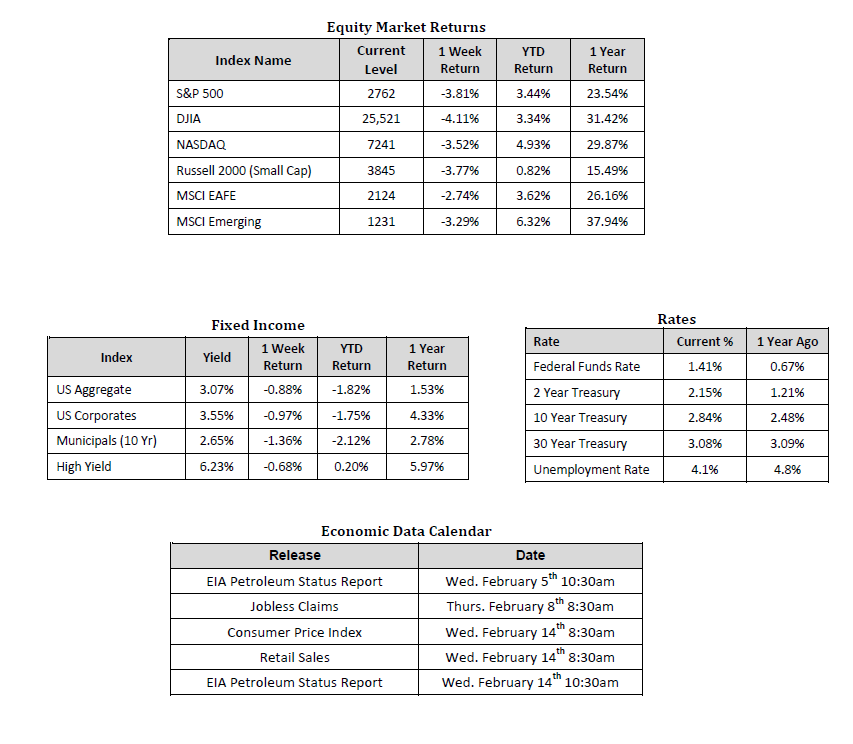
Putting the Sell-Off in Perspective
Market Overview
Sources: Sources for data in tables: Equity Market and Fixed Income returns are from JP Morgan as of 02/02/18. Rates and Economic Calendar Data from Bloomberg as of 02/05/18. International developed markets measured by the MSCI EAFE Index, emerging markets measured by the MSCI EM Index. Sector performance is measured using GICS methodology.
Happening Now
For the first time all year equities had a down week and fell in value across the board. This result perpetuated itself severely during Monday’s trading session when the Dow Jones lost an additional 4.6% or 1,175 points. Holding last week in isolation, the S&P 500 Index and the Russell 2000 Index each fell 3.8%, while the Russell Midcap Index dropped 3.9%. Internationally, developed markets fell 2.7% while emerging markets ended the week with a 3.3% drop.
Last week’s drop in stock prices coincided with rising bond yields, and subsequently, lower bond prices. This proved to be a difficult environment for diversified investors who typically rely on bond and stock prices to move in opposite directions in order to help balance each other out during volatile times. These unusual price moves were completely overshadowed by Monday’s dramatic sell-off which had many investors scratching their collective heads, looking for a smoking gun. With a strong global economy, persistent earnings growth, and fiscal spending on the horizon, the backdrop appears constructive for equities. Why then would the largest daily sell-off in percentage points since 2011 have occurred? In all likelihood, this will prove to be driven by technical trading strategies and an unwinding of positions built to profit on the historical period of low volatility that existed throughout 2017.
We believe that several lessons can be learned from the volatility we saw on Friday and Monday. First is the importance of diversification within the U.S. Stock Market. Being overweight a certain sector can cause a correction to impact your portfolio more severely than it otherwise would have in a more balanced approach. For example, energy stocks fell 6.4% last week, underperforming the market by 2.6%. Those seeking the high dividend yield of MLPs or forecasting higher oil prices may be unintentionally overweight the Energy sector, and in turn, could now have a harder time catching-up when the market recovers. Similarly, only owning a handful of individual stocks may not deliver enough exposure to the overall universe of equities. In order to help recover with the market; one must essentially own the market. If only a portion of the S&P 500 Index is represented in a portfolio, it is possible to miss out on growth when prices ultimately rebound. A second lesson to be learned is the benefit of international diversification. While some have the misconception that international stocks are too risky to invest in, developed international markets provided some protection during last week and Monday’s sell-off, outperforming U.S. companies by a combined 4.6% over that six day period.
Finally, investors need to set appropriate expectations for the amount of risk that is normally involved with owning stocks. After nearly two years without a pullback or correction, it’s easy to get lulled to sleep and be mentally unprepared for a sell-off. Consider that from 1900-2010, there was a stock market correction of 10% on average once per year.
We encourage investors to use this market downturn as an opportunity to revisit their risk tolerance.
Important Information and Disclaimers
Disclosures: Hennion & Walsh is the sponsor of SmartTrust® Unit Investment Trusts (UITs). For more information on SmartTrust® UITs, please visit www.smarttrustuit.com. The overview above is for informational purposes and is not an offer to sell or a solicitation of an offer to buy any SmartTrust® UITs. Investors should consider the Trust’s investment objective, risks, charges and expenses carefully before investing. The prospectus contains this and other information relevant to an investment in the Trust and investors should read the prospectus carefully before they invest.
Investing in foreign securities presents certain risks not associated with domestic investments, such as currency fluctuation, political and economic instability, and different accounting standards. This may result in greater share price volatility. These risks are heightened in emerging markets.
There are special risks associated with an investment in real estate, including credit risk, interest rate fluctuations and the impact of varied economic conditions. Distributions from REIT investments are taxed at the owner’s tax bracket.
The prices of small company and mid cap stocks are generally more volatile than large company stocks. They often involve higher risks because smaller companies may lack the management expertise, financial resources, product diversification and competitive strengths to endure adverse economic conditions.
Investing in commodities is not suitable for all investors. Exposure to the commodities markets may subject an investment to greater share price volatility than an investment in traditional equity or debt securities. Investments in commodities may be affected by changes in overall market movements, commodity index volatility, changes in interest rates or factors affecting a particular industry or commodity.
Products that invest in commodities may employ more complex strategies which may expose investors to additional risks.
Investing in fixed income securities involves certain risks such as market risk if sold prior to maturity and credit risk especially if investing in high yield bonds, which have lower ratings and are subject to greater volatility. All fixed income investments may be worth less than original cost upon redemption or maturity. Bond Prices fluctuate inversely to changes in interest rates. Therefore, a general rise in interest rates can result in the decline of the value of your investment.
Definitions
MSCI- EAFE: The Morgan Stanley Capital International Europe, Australasia and Far East Index, a free float-adjusted market capitalization index that is designed to measure developed-market equity performance, excluding the United States and Canada.
MSCI-Emerging Markets: The Morgan Stanley Capital International Emerging Market Index, is a free float-adjusted market capitalization index that is designed to measure the performance of global emerging markets of about 25 emerging economies.
Russell 3000: The Russell 3000 measures the performance of the 3000 largest US companies based on total market capitalization and represents about 98% of the investible US Equity market.
ML BOFA US Corp Mstr [Merill Lynch US Corporate Master]: The Merrill Lynch Corporate Master Market Index is a statistical composite tracking the performance of the entire US corporate bond market over time.
ML Muni Master [Merill Lynch US Corporate Master]: The Merrill Lynch Municipal Bond Master Index is a broad measure of the municipal fixed income market.
Investors cannot directly purchase any index.
LIBOR, London Interbank Offered Rate, is the rate of interest at which banks offer to lend money to one another in the wholesale money markets in London.
The Dow Jones Industrial Average is an unweighted index of 30 “blue-chip” industrial U.S. stocks.
The S&P Midcap 400 Index is a capitalization-weighted index measuring the performance of the mid-range sector of the U.S. stock market, and represents approximately 7% of the total market value of U.S. equities. Companies in the Index fall between S&P 500 Index and the S&P SmallCap 600 Index in size: between $1-4 billion.
DJ Equity REIT Index represents all publicly traded real estate investment trusts in the Dow Jones U.S. stock universe classified as Equity REITs according to the S&P Dow Jones Indices REIT Industry Classification Hierarchy. These companies are REITs that primarily own and operate income-producing real estate.




